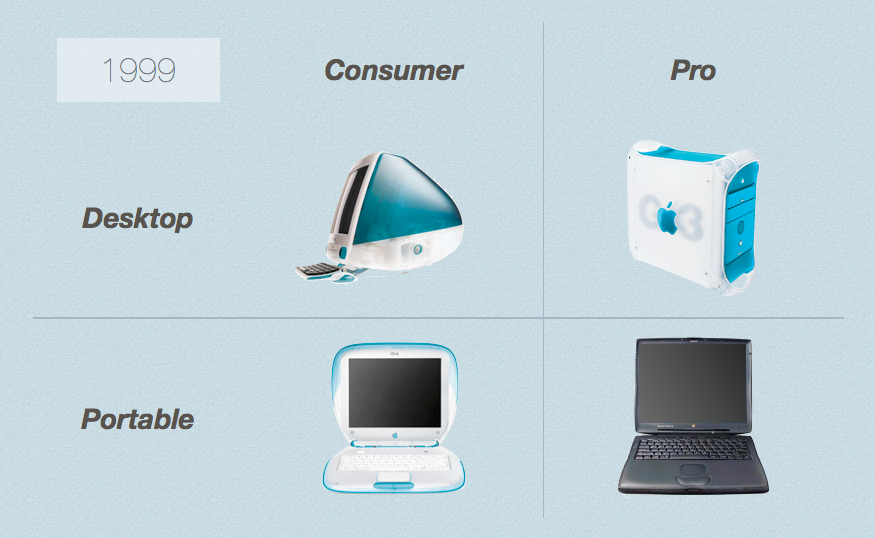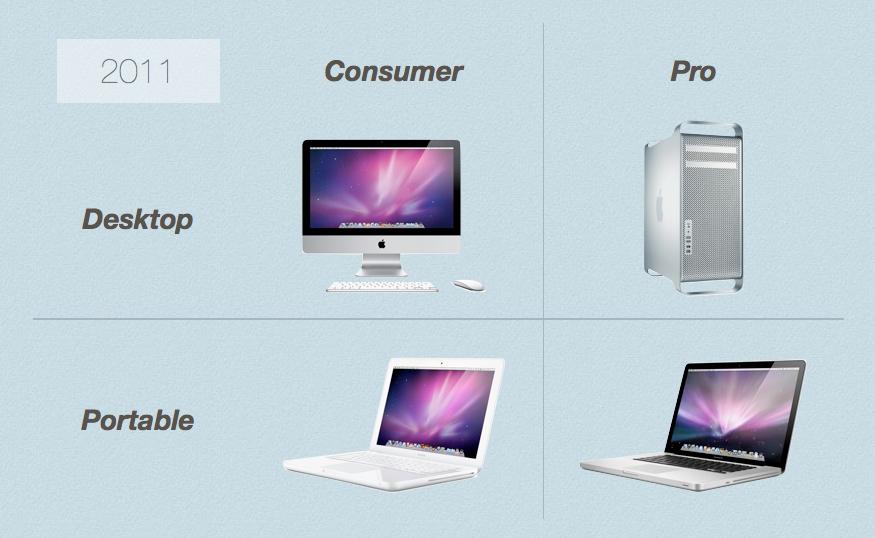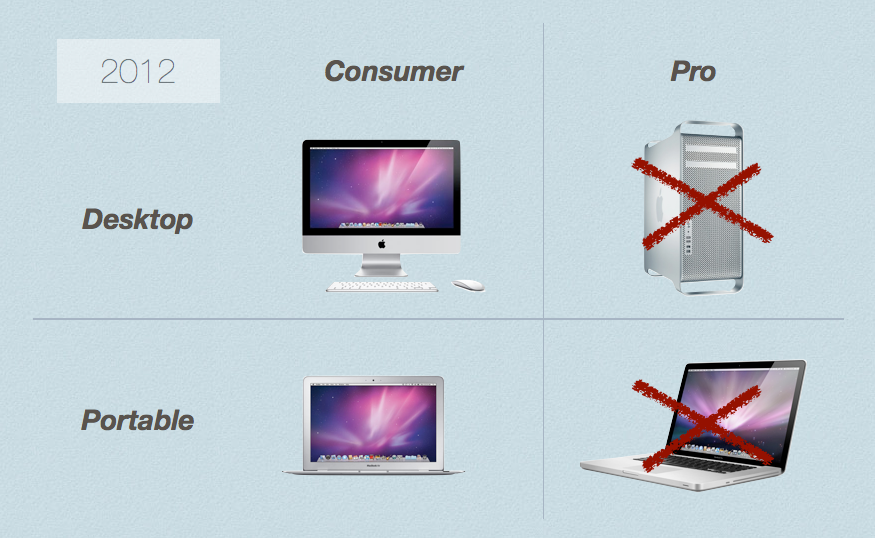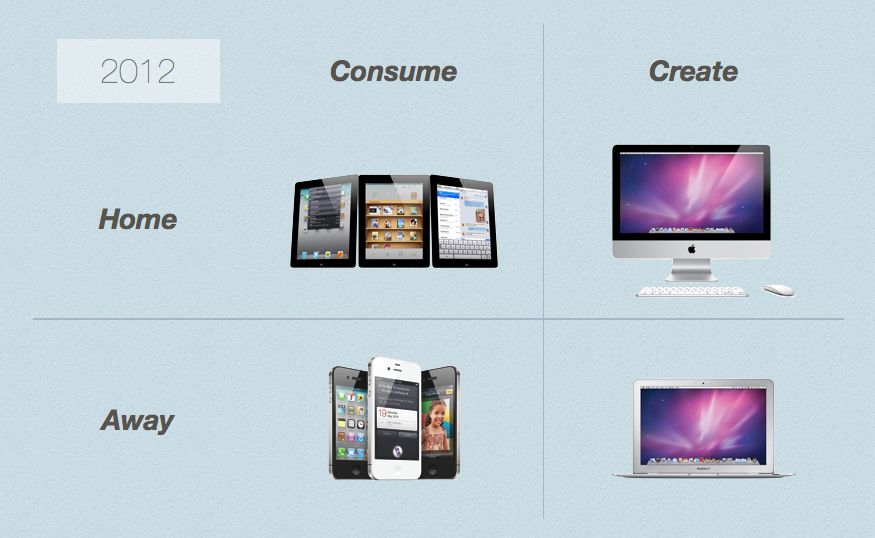the new grid figure 1 upon returning to apple




The New Grid
Figure 1
Upon returning to Apple in 1997, Jobs toured the company in an attempt to understand its products and how they fit together. He found a dozen versions of the Mac, each with a confusing name and built without perspective for what other teams were building. After many meetings, and many cut products, it all snapped into place. Isaacson writes:
“Stop!” he shouted at one big product strategy session. “This is crazy.” He grabbed a magic marker, padded to a whiteboard, and drew a horizontal and vertical line to make a four-squared chart. “Here’s what we need,” he continued. Atop the two columns he wrote “Consumer” and “Pro”; he labeled the two rows “Desktop” and “Portable.” Their job, he said, was to make four great products, one for each quadrant. “The room was in dumb silence,” Schiller recalled.
…
The result was that the Apple engineers and managers suddenly became sharply focused on just four areas. For the professional desktop quadrant, they would work on making the Power Macintosh G3. For the professional portable, there would be the PowerBook G3. For the consumer desktop, work would begin on what became the iMac. And for the consumer portable, they would focus on what would become the iBook. (pp. 337-338).
Figure 2
12 years later, The Grid held true. Along with ‘the computer as a hub for your digital life’, the Grid strategy helped lead Apple to become the 2nd largest company in the world.
The Grid’s brilliance is its simplicity and that it gives the Consumer equal billing with the Professional. Each quadrand was crucial and each product was to be taken seriously.
At the time, this tactic was radical. Companies like Dell and Compaq employed a trickle down strategy when it came to consumer PCs: features from enthusiast and professional models trickled down into consumer wares as they fell below a certain cost. This strategy hamstrung consumer efforts. Consumer innovation wasn’t synicated across additional product lines so it was seen as being less valuable.
With Job’s Grid, consumer machines were taken seriously. Design resources, technical innovations, and component procurement took place in all quadrants. With the Grid came a point of view: computing is for everyone, so we’ll design PCs for everyone. Besides building Better consumer machines, the Grid created two flows of innovation as each column was able to inform the other.
12 years later, this is the last revision of The Grid in its original form.
Figure 3
This is a projection, but one which seems unavoidable.
Apple stopped selling the MacBook last July, though it’s still available to educational institutes (a twilight if there ever was one). Without the MacBook in the consumer quadrant the Air, which never really fit within the original grid, shifts into the consumer spot. And it’s a nice1 fit: Air sales now make up 28% of Apple laptop sales, up from 8% prior to the shift.
As for the MacBook Pro, rumors and leaks are hinting at 15 inch MacBook Airs for the first quarter of 2012. While these sites wonder if these models are an addition to the Air line or a revision to the Pro model, it’s my belief that we’ll see a unification of the two lines shortly. The performance gap between the two products is closing quickly, optical drives are falling out of favor, and it’s clear Apple sees solid-state as the future of local storage.
Moving up, signs are pointing to the Mac Pro’s impending demise. We won’t delve too deeply into the ‘why’ here, as many have already discussed potential reasons for the line’s demise.
It’s easy to imagine Apple unifying the MacBook Pro and Air lines into a simple MacBook range, moving the iMac to a simple ‘Mac’ moniker, and keeping the Mini as a flexible computer for an aggregate of the niche audiences: developers, home theater hackers, and other technological Lewis & Clarks who explore potential futures prior to mass settlement.
Which leaves us with half a grid.
Which begs the question, why the sudden consolidation after more than a decade? In a nutshell, technological advances allowed us to offloaded components and cultural changes redefined the idea of a ‘professional’, both for products and people.
Computer components are being offloaded to external devices, both local and distant.
Locally, ports shrank and became faster. In the case of Thunderbolt, they became fast enough to externalize internal protocals and house fast, redundant storage externally. Apple even presents “External Thunderbolt Storage” as a configuration option when purchasing a Mac.
Distantly, near-constant broadband connections have made cloud capabilities conceivable. Cloud processing is just beginning in consumer devices: Amazon’s Silk browser handles much of it’s processing in Amazon’s server farms before routing the output to the Kindle Fire. Cloud storage is nearing a tipping point. With the launch of iTunes Match, it feels like my MacBook Air received a storage upgrade. It’s mediocre 128 GB internal storage suddenly feels roomy with most of my music library stashed in the cloud.
Once the kinks are worked out of iCloud backup on the iOS side, I’d wager we’d see similar implimentations on Macs. Future versions of Mac OS X will appear to have infinite storage, which will cache stale files in iCloud and keep local copies of recent items.
Redefining the idea of what it means to be ‘professional’, for devices or people, is a seperate post (or book!) in it of itself. Simply put, there are fewer ‘professionals’ and many, many more professional ‘consumers’.
To me, this idea became apparent only recently, but it coalesces several trends, including improved means of production for the masses2, crowdsourcing, and high unemployment. A perfect example of the dissolution of the ‘professional’ can be seen in CNN’s recent layoffs, which traded staff photographers for citizen journalists.
When computers can be improved by improving a central location and amateur computer users perform professional functions, we can expect the Grid to evolve into a single column of ‘production’ computing.
Figure 4
This is a take on the new normal. It’s imperfect, to be sure, but I think it captures the spirit of where we’re going. ‘Create’ and ‘Consume’ are soft categories here, much in the way that some worked Pros used iMacs and some Consumers used MacBook Pros. There are better words for these columns; drop me a line if you any come to you.
Each quadrant is a different interface for remote stuff: people, files, photos, writing, books, movies, code, companies, and so on. Assuming an omnipresent cloud suggests that device design innovation will take place in two areas: interface design and power, both consumption and storage. These are the main device-bound metrics, the ones we can’t offload to the cloud.
For some, the arrangement of the new Grid might seem obvious, but it contains a bit of genius similar to the original Grid: it takes mobile, lightweight computing seriously.
This viewpoint lead to the iPhone. Rather than wondering how to plus up a phone, Apple imagined a perfect palm computer. If this doesn’t sound disruptive, remember that at launch most saw the iPhone as an evolution of the iPod. Today it’s easier to see it as an evolution of the computer.
Like the old Grid, the new Grid contains a worldview. It takes for granted computing within a network context and treats mobile, lightweight devices as true computers. Further, the new Grid assumes that users have more deeply integrated technology into their lives.
Today we’re rarely without access to the internet and maintain disparate friendships with digital services. Last week, MG Siegler summed up how far we’ve come rather nicely: “What would Facebook look like in the 1980s? Scary as hell.”
MG’s right. In barely a decade we’ve integrated computers into our lives while devices have dispersed their components around the world. With these changes The Grid must adjust. Being a well-designed household appliance is no longer a noble goal for a computer. Given an always-on network context and an eagerly digital userbase, computers need to aim for so much more.
Though this move creates some liguistic awkwardness: Apple is now selling a MacBook Pro and a MacBook Air, but not a MacBook. Initially, there was even a naming system that fit each component of The Grid, which Steve Jobs explained during the introduction of the iBook: “As you know we tend to start our consumer products with the prefix ‘i’ and our pro products with the prefix ‘Power.’ And we tend to end our desktops with ‘Mac’ and we tend to end our portables with ‘Book.’ Since we’re such logical folk, iBook is the name of this product.” ↩︎
One could measure this a few ways for each medium, usually based on quality per dollar or quality-device penetration per population. An example of each would be megapixels per dollar and megapixels per person. I prefer the latter view, as it indicates actual adoption. ↩︎